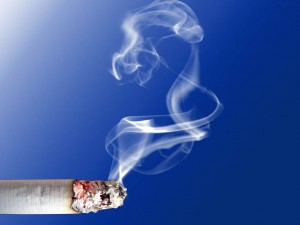Smoking Cessation for Asbestos Workers Dramatically Reduces Lung Cancer Risk
Jul 28th, 2013 | By Michael Bittner | Category: Health and Safety
Employers who have asbestos in their workplace in the United States are required to provide annual awareness training that includes information on the health effects associated with asbestos exposure and the relationship between smoking and asbestos exposure in causing lung cancer. This training is required by 29 CFR 1910.1001(j)(7) for general industry, 29 CFR 1926.1101(k)(9) for the construction industry, and 29 CFR 1915.1001 (k)(9) for ship repairing, shipbuilding, shipbreaking, and related employments.
Trailing below is a great article on the interaction of asbestos exposure and smoking from Asbestos.com. The article describes the health benefits of smoking cessation and would make an excellent training handout or communication piece.
Asbestos and Smoking Cessation
Smoking cessation can be a key step to a healthier future for almost anyone.
It’s even more important for those with extended asbestos exposure.
It’s well documented that the chances of developing lung cancer increase dramatically when smoking is combined with asbestos exposure, but a recent study also has proven just how dramatically those same odds can drop once a lifelong smoker has stopped the habit.
According to the study in the American Journal of Respiratory and Critical Care Medicine, smoking cessation prompted an almost 50 percent decrease in lung cancer rates for asbestos-insulation workers.
“Since your risk of lung cancer is so much higher (if you worked with asbestos and smoked) than anyone else’s, it’s all the more important that you quit (smoking),” said Steven Markowitz, M.D., PhD, professor of occupational and environmental medicine at Queens College in New York, who led the study. “When your risk drops by half, that’s very meaningful.”
Asbestos and Smoking Multiply Risk
The study, which examined the lung-cancer interaction among asbestos exposure, asbestosis and smoking, included 2,377 long-term North American insulators, and more than 54,000 blue-collar male workers with no history of asbestos exposure.
It found that among nonsmokers, the rate of dying from lung cancer increased 5.2-fold with the extended exposure to asbestos. Smoking and asbestos exposure together raised the risk 28-fold. And the risk increased 38-fold for smokers exposed to asbestos who also had signs of asbestosis, a slow scarring of the lung tissue.
Exposure to asbestos can lead to any number of respiratory problems, including mesothelioma cancer, lung cancer and asbestosis.
Asbestos is a mineral that was used by manufacturers in the 20th century because of its ability to strengthen, insulate and fireproof. Even though its use has dropped dramatically, asbestos remains an issue in anything built before the mid-1980s. It still is used extensively in many roofing materials. Microscopic asbestos fibers become especially dangerous when they age, or are disturbed and become airborne. When they are unknowingly inhaled, they can lodge in the lining of the lungs and begin a slow scarring process that leads to problems. It often can take 10 to 40 years from the time of first inhalation before symptoms of mesothelioma or lung cancer become evident.
It’s Never Too Late to Quit Smoking
“There’s nothing you can do about the asbestos fibers that stuck around. There is no medicine you can take, but given a history of exposure, you can stop smoking,” Markowitz told Asbestos.com. “Everybody knows the importance of smoking cessation for a guy never exposed to asbestos, but if you worked around asbestos, it’s even more important.”
Lung cancer mortality among asbestos insulators dropped from 177 deaths per 10,000 to 90 per 10,000 after 10 years for those who quit smoking. Lung cancer rates for insulators who had stopped smoking 30 years earlier were similar to those who had never smoked.
“A lot of asbestos workers who also smoked might be thinking, ‘I’m really cooked,’ and it’s not worth the effort to quit smoking at this point,” Markowitz said. “But the study really drives home the point that it’s never too late. It sends a message that you can have all that asbestos exposure over many years, but if you quit smoking today, your lung cancer risk still can drop by 50 percent. That’s really significant.”
About the Author
An award-winning reporter and writer, Tim Povtak is a senior content writer for The Mesothelioma Center. He previously worked at the Orlando Sentinel and then at AOL.
About The Mesothelioma Center
The Mesothelioma Center provides the most relevant information on asbestos exposure and malignant mesothelioma cancer. For more information visit them at Asbestos.com.
Photograph: Smoking and Moving Cigarette by Gabriella Fabbri, Italy.


I completely agree with the article. However, all cautions must be taken with regards to entry points of Asbestos into ones system. PPE, showers and proper ventalation. I once inspected a closed in sight and noticed a worker with a mouthful of sunflowers seeds. He explained he was trying to quit smoking. I explained to him the hazard of injestion. He was actually lifting his mask to spit out the sunflower seeds and as well to put more in his mouth. While I do agree with the information as set forth it is important to properly train and supervise the men.